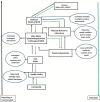Performance of COVID-19 case-based surveillance system in FCT, Nigeria, March 2020 -January 2021
- PMID: 35421123
- PMCID: PMC9009682
- DOI: 10.1371/journal.pone.0264839
Performance of COVID-19 case-based surveillance system in FCT, Nigeria, March 2020 -January 2021
Abstract
Introduction: The emergence of novel SARS-CoV-2 has caused a pandemic of Coronavirus Disease 19 (COVID-19) which has spread exponentially worldwide. A robust surveillance system is essential for correct estimation of the disease burden and containment of the pandemic. We evaluated the performance of COVID-19 case-based surveillance system in FCT, Nigeria and assessed its key attributes.
Methods: We used a cross-sectional study design, comprising a survey, key informant interview, record review and secondary data analysis. A self-administered, semi-structured questionnaire was administered to key stakeholders to assess the attributes and process of operation of the surveillance system using CDC's Updated Guidelines for Evaluation of Public Health Surveillance System 2001. Data collected alongside surveillance data from March 2020 to January 2021 were analyzed and summarized using descriptive statistics.
Results: Out of 69,338 suspected cases, 12,595 tested positive with RT-PCR with a positive predictive value (PPV) of 18%. Healthcare workers were identified as high-risk group with a prevalence of 23.5%. About 82% respondents perceived the system to be simple, 85.5% posited that the system was flexible and easily accommodates changes, 71.4% reported that the system was acceptable and expressed willingness to continue participation. Representativeness of the system was 93%, stability 40%, data quality 56.2% and timeliness 45.5%, estimated result turnaround time (TAT) was suboptimal.
Conclusion: The system was found to be useful, simple, flexible, sensitive, acceptable, with good representativeness but the stability, data quality and timeliness was poor. The system meets initial surveillance objectives but rapid expansion of sample collection and testing sites, improvement of TAT, sustainable funding, improvement of electronic database, continuous provision of logistics, supplies and additional trainings are needed to address identified weaknesses, optimize the system performance and meet increasing need of case detection in the wake of rapidly spreading pandemic. More risk-group persons should be tested to improve surveillance effectiveness.
Conflict of interest statement
The authors have declared that no competing interests exist.
Figures






Similar articles
-
Effectiveness and cost-effectiveness of four different strategies for SARS-CoV-2 surveillance in the general population (CoV-Surv Study): a structured summary of a study protocol for a cluster-randomised, two-factorial controlled trial.Trials. 2021 Jan 8;22(1):39. doi: 10.1186/s13063-020-04982-z. Trials. 2021. PMID: 33419461 Free PMC article.
-
Evaluation of malaria surveillance system in Kano State, Nigeria, 2013-2016.Infect Dis Poverty. 2020 Feb 10;9(1):15. doi: 10.1186/s40249-020-0629-2. Infect Dis Poverty. 2020. PMID: 32036790 Free PMC article.
-
An evaluation of COVID-19 surveillance system in New Juaben South Municipality of Ghana: a cross-sectional study.Pan Afr Med J. 2021 Dec 6;40:206. doi: 10.11604/pamj.2021.40.206.30715. eCollection 2021. Pan Afr Med J. 2021. PMID: 35136469 Free PMC article.
-
Evaluation of the pilot wastewater surveillance for SARS-CoV-2 in Norway, June 2022 - March 2023.BMC Public Health. 2023 Sep 4;23(1):1714. doi: 10.1186/s12889-023-16627-2. BMC Public Health. 2023. PMID: 37667223 Free PMC article.
-
Effect of COVID-19 pandemic on provision of sexual and reproductive health services in primary health facilities in Nigeria: a cross-sectional study.Reprod Health. 2021 Aug 4;18(1):166. doi: 10.1186/s12978-021-01217-5. Reprod Health. 2021. PMID: 34348757 Free PMC article.
Cited by
-
A cross-sectional survey of COVID-19 testing status among vaccine recipients in Gombe State, North-Eastern Nigeria.BMC Public Health. 2025 Mar 26;25(1):1153. doi: 10.1186/s12889-025-22311-4. BMC Public Health. 2025. PMID: 40140785 Free PMC article.
-
Evaluating Senegal's COVID-19 surveillance system for early detection and response: lessons from the Keur Massar district, March 03, 2020 to May 31, 2022.BMC Public Health. 2024 Nov 22;24(1):3246. doi: 10.1186/s12889-024-20692-6. BMC Public Health. 2024. PMID: 39574057 Free PMC article.
-
Insights into COVID-19 data collection and management in Malawi: exploring processes, perceptions, and data discrepancies.Wellcome Open Res. 2024 Apr 24;9:217. doi: 10.12688/wellcomeopenres.21131.1. eCollection 2024. Wellcome Open Res. 2024. PMID: 39114492 Free PMC article.
-
Challenges and Opportunities for Global Genomic Surveillance Strategies in the COVID-19 Era.Viruses. 2022 Nov 16;14(11):2532. doi: 10.3390/v14112532. Viruses. 2022. PMID: 36423141 Free PMC article. Review.
-
Systems analysis of the effects of the 2014-16 Ebola crisis on WHO-reporting nations' policy adaptations and 2020-21 COVID-19 response: a systematized review.Global Health. 2023 Dec 5;19(1):96. doi: 10.1186/s12992-023-00997-8. Global Health. 2023. PMID: 38053050 Free PMC article.
References
-
- WHO. WHO Coronavirus (COVID-19) Dashboard With Vaccination Data. Available from: https://covid19.who.int/
-
- Shi Y, Wang G, peng Cai X, wen Deng J, Zheng L, hong Zhu H, et al.. An overview of COVID-19. J Zhejiang Univ Sci B. 2020;21(5):343–60. Available from: https://pubmed.ncbi.nlm.nih.gov/32425000/ doi: 10.1631/jzus.B2000083 - DOI - PMC - PubMed
-
- Elimian KO, Ochu CL, Ilori E, Oladejo J, Igumbor E, Steinhardt L, et al.. Descriptive epidemiology of coronavirus disease 2019 in Nigeria, 27 February-6 June, 2020. Epidemiol Infect. 2020;148:1–16. Available from: https://www.ncbi.nlm.nih.gov/pmc/articles/PMC7506173/ - PMC - PubMed
-
- NCDC. COVID-19 Situation Report. Available from: https://ncdc.gov.ng/diseases/sitreps/An update of COVID-19 outbreak in Nigeria_220121_4
-
- Elimian KO, Ochu CL, Ebhodaghe B, Myles P, Crawford EE, Igumbor E, et al.. Patient characteristics associated with COVID-19 positivity and fatality in Nigeria: retrospective cohort study. BMJ Open. 2020;10(12):e044079. Available from: https://bmjopen.bmj.com/content/10/12/e044079 doi: 10.1136/bmjopen-2020-044079 - DOI - PMC - PubMed
MeSH terms
LinkOut - more resources
Full Text Sources
Medical
Miscellaneous

